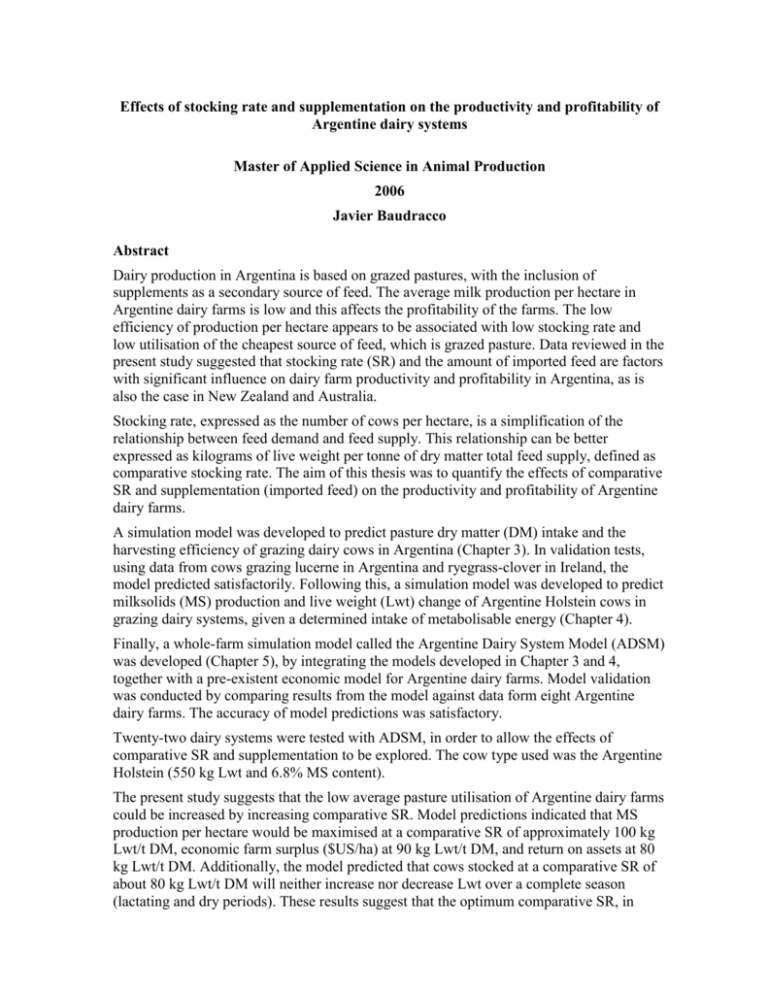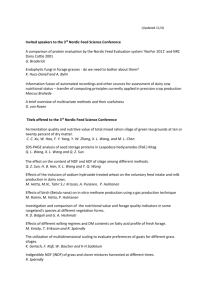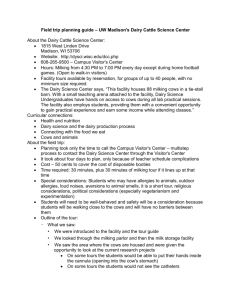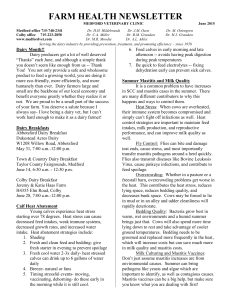Effects of stocking rate and supplementation on the productivity and
advertisement

Effects of stocking rate and supplementation on the productivity and profitability of Argentine dairy systems Master of Applied Science in Animal Production 2006 Javier Baudracco Abstract Dairy production in Argentina is based on grazed pastures, with the inclusion of supplements as a secondary source of feed. The average milk production per hectare in Argentine dairy farms is low and this affects the profitability of the farms. The low efficiency of production per hectare appears to be associated with low stocking rate and low utilisation of the cheapest source of feed, which is grazed pasture. Data reviewed in the present study suggested that stocking rate (SR) and the amount of imported feed are factors with significant influence on dairy farm productivity and profitability in Argentina, as is also the case in New Zealand and Australia. Stocking rate, expressed as the number of cows per hectare, is a simplification of the relationship between feed demand and feed supply. This relationship can be better expressed as kilograms of live weight per tonne of dry matter total feed supply, defined as comparative stocking rate. The aim of this thesis was to quantify the effects of comparative SR and supplementation (imported feed) on the productivity and profitability of Argentine dairy farms. A simulation model was developed to predict pasture dry matter (DM) intake and the harvesting efficiency of grazing dairy cows in Argentina (Chapter 3). In validation tests, using data from cows grazing lucerne in Argentina and ryegrass-clover in Ireland, the model predicted satisfactorily. Following this, a simulation model was developed to predict milksolids (MS) production and live weight (Lwt) change of Argentine Holstein cows in grazing dairy systems, given a determined intake of metabolisable energy (Chapter 4). Finally, a whole-farm simulation model called the Argentine Dairy System Model (ADSM) was developed (Chapter 5), by integrating the models developed in Chapter 3 and 4, together with a pre-existent economic model for Argentine dairy farms. Model validation was conducted by comparing results from the model against data form eight Argentine dairy farms. The accuracy of model predictions was satisfactory. Twenty-two dairy systems were tested with ADSM, in order to allow the effects of comparative SR and supplementation to be explored. The cow type used was the Argentine Holstein (550 kg Lwt and 6.8% MS content). The present study suggests that the low average pasture utilisation of Argentine dairy farms could be increased by increasing comparative SR. Model predictions indicated that MS production per hectare would be maximised at a comparative SR of approximately 100 kg Lwt/t DM, economic farm surplus ($US/ha) at 90 kg Lwt/t DM, and return on assets at 80 kg Lwt/t DM. Additionally, the model predicted that cows stocked at a comparative SR of about 80 kg Lwt/t DM will neither increase nor decrease Lwt over a complete season (lactating and dry periods). These results suggest that the optimum comparative SR, in terms of both economic and sustainable physical performance for the Argentine Holstein cows seems to be around 80 kg Lwt/t DM. Annual pasture utilization values were 70%, 76%, and 81% for comparative SRs of 80, 90, and 100 kg Lwt /t DM, respectively. At the milk payout and concentrates price used in this study, it would be profitable to increase the amount of imported feed up to 3.6 t DM per hectare, provided that SR is simultaneously increased, in order to achieve pasture utilisation of 70% or higher. A dairy system with 8.6 t DM/ha/year produced on-farm, importing 3.6 t DM concentrates per year and stocked at 81 kg Lwt/t DM (1.8 cows/ha) would be able to utilise 71% of pasture and produce 626 kg MS/ha/year, which is about two-fold the average MS production of Argentine farms. Changing either the price of milk or the cost of concentrates by 10% did not alter the relative profitability of the different systems.






